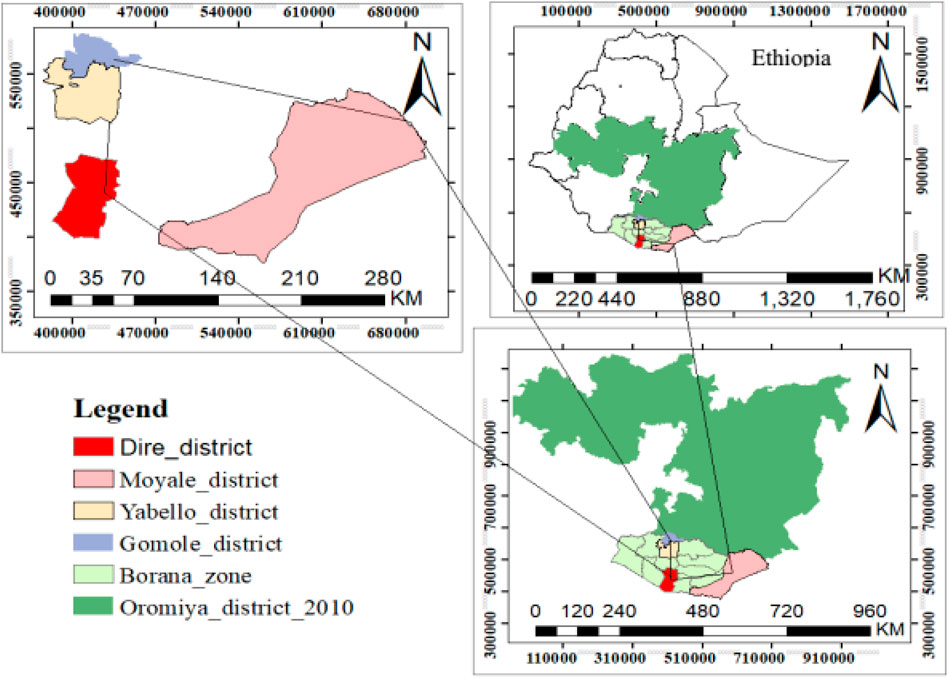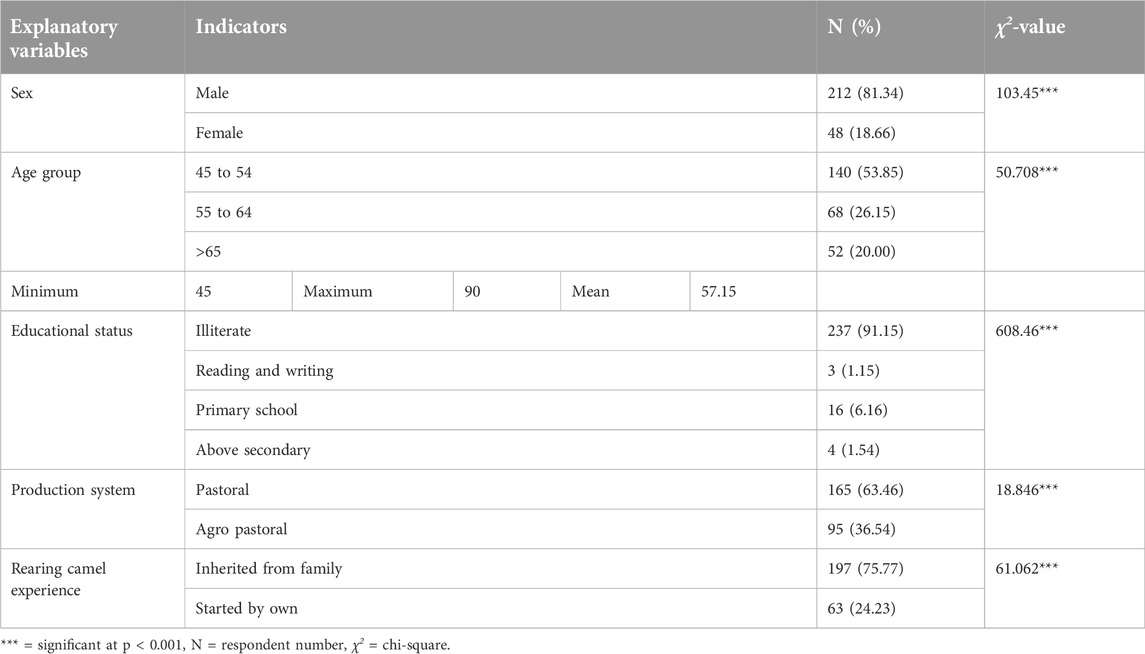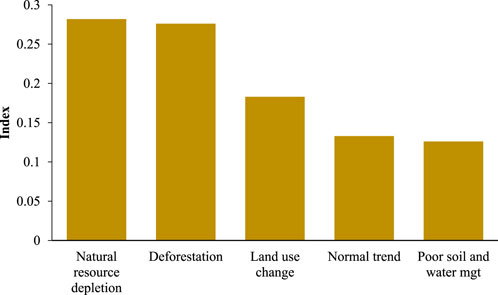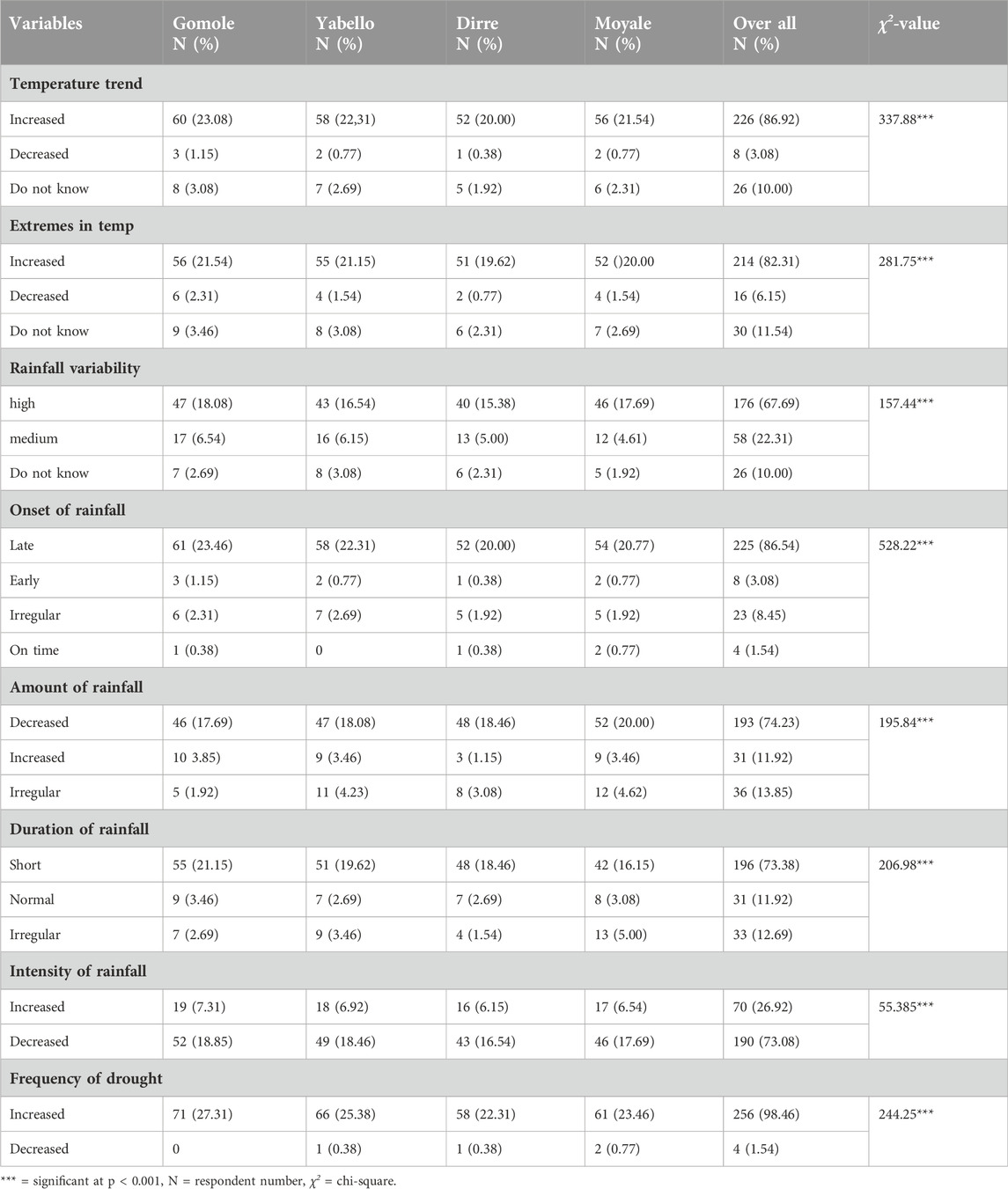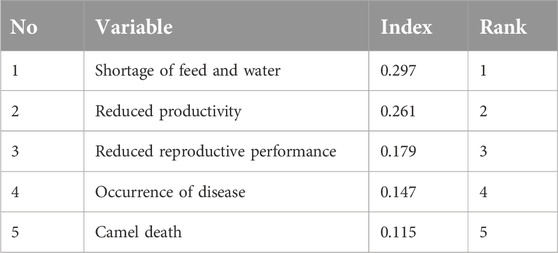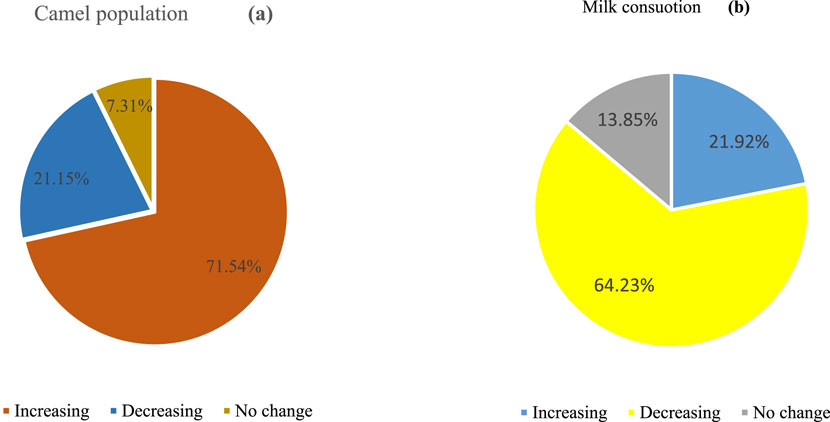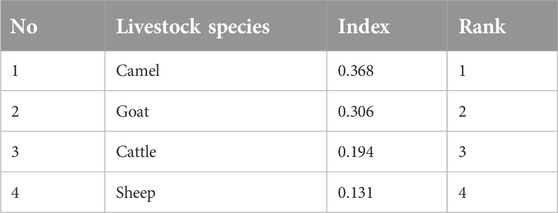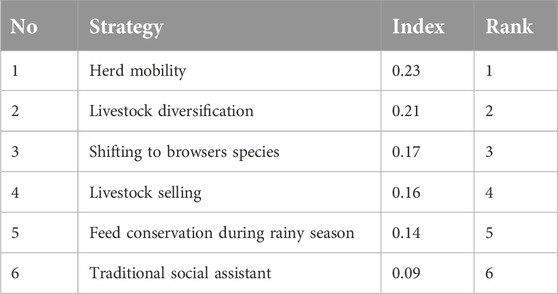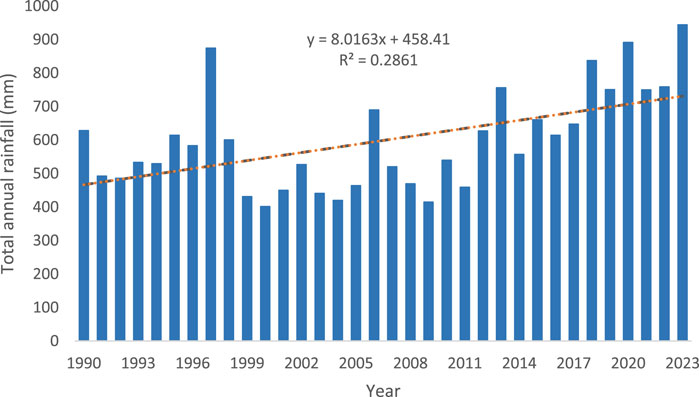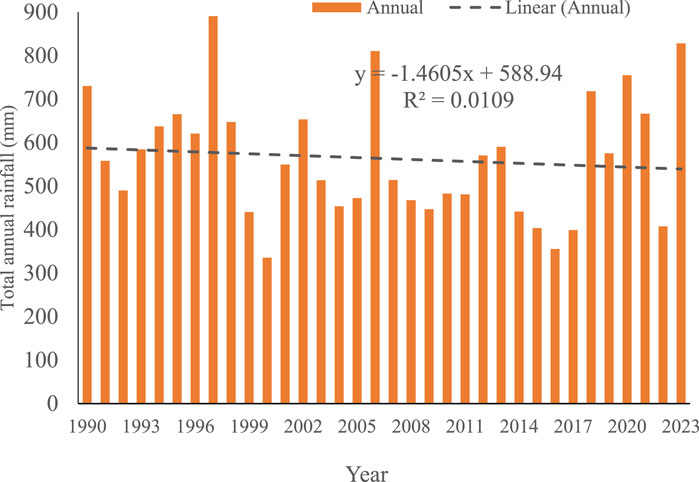- 1Oromia Agricultural Research Institute, Yabello Pastoral and Dryland Agriculture Research Center, Yabello, Ethiopia
- 2School of Animal and Range Science, Haramya University, Dire Dawa, Ethiopia
- 3Bio and Emerging Technology Institute (BETin), Addis Ababa, Ethiopia
- 4Ethiopian Institute of Agricultural Research, Holeta Agriculture Research Center, Holeta, Ethiopia
Camel production is under climatic stress, where it plays a significant role in the livelihood and food security of camel herders in the Borana areas. Camel herders’ perceptions of climate change and variability are essential in response to climatic challenges and maintaining sustainable camel production. The aim of this study was to assess perceptions of camel herders about climate change and variability in relation to camel production in Borana Zone. A total of 260 respondents were selected based on systematic random and purposive sampling targeting camel herders. Over 34 years (from 1990 to 2023) of meteorological data were taken from the Ethiopian National Meteorology Institute. The study showed that 86.92% of the respondents perceived an increase in temperature trends, while 74.23% and 73.08% of them perceived a decrease in the amount and intensity of rainfall, respectively. Among respondents, 67.69%, 86.54%, and 73.38% of the respondents perceived high variability, late onset, and short duration of rainfall in the last three decades, respectively. Similarly, meteorological data confirmed that both mean annual maximum and minimum temperatures increased significantly (P < 0.01). Meteorological data showed 25% and 32%–66% of medium annual and high seasonal rainfall variations, respectively. Respondents observed, besides the high number of cattle deaths, reduced productivity and reproductive performance of camels as causes of recent climate change and variability. Under this climatic stress, respondents preferred the production of camels, followed by goats, and they used different adaptation mechanisms to cope with climate change effects. This findings confirmed respondents perceived the variations of rainfall and increased temperature consistent with meteorological data. Therefore, considering the perception of camel herders, systematic prediction and adaptation of climate change and variability are needed to reduce the impact of climate threats and thereby improve the resilience of camel owners in the study areas.
Introduction
Camel (Camelus dromedary) production is an important part of the livestock sector under current climate change and variability (Mirkena et al., 2018; Boudalia et al., 2023). Camel production plays an essential role in the livelihood and food security of camel herder communities around the world in arid and semi-arid areas, including Ethiopia (Kebede et al., 2015; Abri and Faye, 2019). In Ethiopia, Somali, Afar, Borana, Gebra, Guji and others are home to 8.1 million camels in Ethiopia, where diverse communities practice camel husbandry (Mirkena et al., 2018; CSA, 2021). In addition, the country has a diversified climatic zone that includes arid and semi-arid areas suitable for camel production (Bogale and Erena, 2022). However, the country has suffered from climate variability and extremes (NMA, 2007). The consequence of long-term climate change and variability is that changes in rainfall patterns, rainfall variability, and temperature have increased the frequency of droughts and floods (World Bank, 2010). Climate change and variability have an impact on animal production and productivity through land degradation, competition for feed resources, animal diseases, heat stress, and biodiversity loss, while demand for animal products is expected to increase highly (World Bank, 2010; Abebe, 2017).
Perceptions of climate change and its variability play an important role in how farmers, pastoralists, and agro-pastoralists respond to the opportunities and threats (Ochieng et al., 2016; Kargbo et al., 2023). Due to demographics, climates, and production systems, livestock farmers’ perceptions and adaptations to climate change and variability are changing (Ochieng et al., 2016; Olaniyan and Orunmuyi, 2017; Kargbo et al., 2023). The types of adaptations that are possible and how well they are implemented depend on how people behave in response to these perceptions (Debela et al., 2015; Tofu et al., 2023). Climate change and variability threats have caused the Ethiopian agricultural sector’s performance in livestock production to fluctuate, resulting in high disease prevalence and seasonal feed shortages (Bogale and Erena, 2022). The introduction of innovative technologies is significantly influenced by livestock farmers' knowledge of the causes and effects of climatic fluctuations (Kimaro et al., 2018). It has been reported that farmers’ knowledge of current climate changes is influenced by their past weather experiences (Sanogo et al., 2016) and the frequency of drought events (Kimaro et al., 2018). In the Borana areas, decreasing rainfall, variability in distribution, and the unpredictable nature of rainfall, along with increased temperatures and recurrent drought, were the major climate change-induced risk factors for livestock production as well as the livelihoods of pastoralists and agro-pastoralists (Tamene et al., 2023). The major livelihood and source of income in Borana pastoral and agro-pastoral areas is livestock production. The main livestock kept in Borana areas are cattle, camels, goats, and sheep (Tolera and Abebe, 2007). The area also has good ecological potential for livestock production (Wako et al., 2017).
Currently, climate change and variability affect all livestock species, including camel production and productivity, making most of them vulnerable to water and feed shortages (Godde et al., 2021; Kena, 2022). Researchers have so far carried out a number of studies, the majority of which have focused on the features of crops and cattle productivity, where the concept of herders’ perceptions of climate has been understudied (Megersa et al., 2014; Tofu et al., 2023). In Borana areas, for example, Megersa et al. (2013) and Wako et al. (2017) found a reduction in milk and meat production and the consumption of animal products, which was linked to a higher frequency of recurring droughts and declining trends in rainfall that caused animal losses. However, camel production in pastoral and agro-pastoral settings under climatic stress receives less attention. Climate change and variability are affecting individuals worldwide, especially in East Africa, including Borana, whose livelihoods mostly depend on livestock production (Bogale and Erena, 2022).
The past research findings focused on assessing the effect of climate change and variability on overall livestock species, including cattle, goats, sheep, camels, and equines (Ayal et al., 2018; Habte et al., 2022). On the other hand, the susceptibility of livestock to climate change and variability differs across species (Habte et al., 2022), and farmers' knowledge of current climate changes is influenced by the frequency of drought events (Kimaro et al., 2018). Even though camel management is an adaptation strategy for coping with climate threats in the Borana area (Wako et al., 2017), the production of camels is under stress from climate change and variability in recurrent and recent extreme droughts. According to an unpublished Borana Zone Report, a recent five-season drought from 2021 to 2023 in Borana severely affected all animals, including camels. This report stated that over 2.3 million cattle heads died as a result of livestock losses among Borana pastoralists and agro-pastoralists. In this context, the relationship between camel herders’ perceptions and measurement data to assess climate change and variability is of great importance for designing relevant management interventions and drought management strategies in the areas. In the pastoral and agro-pastoral areas of Borana, there is little information on camel herders’ perceptions of climate change and its impact on camel production. Understanding camel herders’ perceptions of climate change and variability, which form the basis of their indigenous knowledge, is important for formulating and implementing decisions and policies for camel farming management and threat reduction. In addition, the perceptions of camel herders characterize the basic information for motivating and leading research projects on climate change and variability issues. Therefore, the aim of this study was to assess the perceptions of pastoral and agro-pastoral camel herders in Borana regarding climate change and variability in relation to camel production in the Borana areas.
Materials and methods
Description of the study area
The study was conducted in four districts of the Borana zone of a pastoral and agro-pastoral area, namely Gomole, Yabello, Dirre, and Moyale (Figure 1). Borana Zone is found in the southern part of Ethiopia. It shares borders with the west Guji zone to the north, the south Ethiopia regional state to the west, the east Borana zone to the northeast and east, the Somali regional state to the southeast, and Kenya to the south. The Borana zone has four major seasons. These include Gannaa (long rainy season), Adoolessa (cool dry season), Hagayya (short rainy season), and Bona (hot dry season). The main rainy season extends from March to May, whereas the short rainy season lasts from October to November, followed by the long dry season (Worku et al., 2022). The short rains are unreliable, and variable rainfall results in greater variability in forage productivity (Coppock, 1994; Wako et al., 2017). Rainfall is bimodal; 60% of the rainfall occurs between March and May (the main rainy season), followed by a minor peak between September and November (the short rainy season) (Worku et al., 2022). The annual mean maximum and minimum temperatures were 29.66°C and 16.31°C, respectively (Wako et al., 2017).
The Borana area is characterized by pastoral and agro-pastoral production systems (Dirriba et al., 2020b). Livestock production is the primary source of income for the Borana pastoral and agro-pastoral communities. The major livestock kept in Borana areas are cattle, camels, goats, and sheep (Wako et al., 2017). The main feed resources of the area are natural pastures (herbaceous vegetation composed mainly of grasses and forbs and browses such as shrubs, tree leaves, and pods), which show marked seasonal variation in availability and quality based on the variability of rainfall distribution. Besides livestock production, crop production is also practiced in the area. The crop production practice is gradually expanding from the agro-pastoral to the pastoral areas (Wako et al., 2017; Abara et al., 2020).
Sampling procedure and methods of data collection
A preliminary assessment was conducted to get general information on recent camel production and to identify potential camel producer districts to set the research design and to determine the sample size. Thus, a three-stage sampling procedure was employed to select study areas and samples of respondents. In the first stage, four districts, namely Gomole, Yabello, Moyale, and Dirre, were selected purposefully based on their camel production potential, access to the market, and accessibility to roads and towns. In the second stage, the same procedure was followed to select two kebeles (the smallest administrative unit in Ethiopia) from each district, namely Dese-gora and Haro-Bake from Gomole, Dida-Yabello and Dherito from Yabello, Dambi-Sabante and Laga-Sure from Moyale, and Did-Jarsa and Mana Soda from Dirre district. In the third stage, purposefully camel-herding households with camels and production experience in camels, as well as willingness to interview, were selected from these villages. The current number of camel owners (3,825 camel herders) was obtained from the selected kebeles offices, from which 260 sample respondents aged 45 and older were chosen purposively. Since younger age groups are less expected to perceive climate change variability compared to older age groups (Debela et al., 2015). The required sample size was determined based on an adopted formula following Yamane (1967) and Israel (1992), with the most often used at a 95% confidence interval and 6% precision level.
Where n is sample size, N = total household of selected kebeles, e = is precision level.
Sample size
The sample size for each kebele was allocated according to Bowley (1925) formula as follows.
Where ni = assigned sample size of kebele, n = Total sample size, Ni = Household size of single kebele, N = Total household size.
Before the formal survey, a pre-test survey was conducted to collect general background information about the study areas. The information that was collected in the pre-test survey helps to guide the development of the formal survey questionnaire. A personal interview was made with respondents using trained enumerators under close supervision of the researcher. A fully structured, pre-tested questionnaire, personal observations, and discussions were held with household respondents and key informants in the kebele of each district. Ten key informants were purposefully selected from the same respondents used for the household (HH) survey study earlier to undertake a focused group discussion on the general issue that was not addressed during the individual HH survey study and to validate the information gathered in direct interviews. To achieve the objective of this study, the following major data were collected: Data on the respondent’s socioeconomic profile and the perceptions of camel herders on climate variability, such as temperature trend, rainfall amount, its distribution, variability, and other related data, were collected. Moreover, causes and impacts of climate variability, preference of livestock species, opportunity for camel production, and coping strategies for camel production in relation to climate variability were collected. Both primary and secondary data were collected from kebele, districts, zonal offices, and other stakeholders. Qualitative and quantitative data were collected using semi-structured questionnaires, focus group discussions (FGD), and key informant interviews (KII) on productive knowledge and perceptions of camel production in relation to climate variability in the selected districts.
Survey data were collected using the discussion points listed in the questionnaire. The assessment was conducted by explaining the significance of the survey and maintaining a comfortable atmosphere by interesting to the nature of respondents’ pride. Furthermore, the prepared questionnaires were translated into the local language (Afan Oromo). Respondents were interviewed following the face-to-face survey method using the door-to-door approach. For information on climate change and variability, thirty-four years (1990–2023) of daily maximum and minimum temperature and rainfall data were taken from the Ethiopian National Meteorology Institute to analyze rainfall and temperature trends in the study sites. Based on production system and location, among the four selected districts, Yabello and Moyale were selected since the majority of respondents in Yabello district are agro-pastoralists, whereas the majority of respondents in Moyale district are pastoralists. The daily records of climate data were missing, with about 6.42% of rainfall and 5.2% of temperature. However, the missed values were assumed based on the estimation method of climatological data, where the missing values equal the mean of the same period of non-missing years (Hasanpour and Dinpashoh, 2012; Iwueze et al., 2018).
Key informant interviews and focus group discussion
A key informant interview was conducted to obtain a general overview of the perceptions of pastoral and agro-pastoral practices on camel production under climate variability and the impacts of climate variability on camel production, as well as the socio-economics of the communities following (Geilfus, 2008). Accordingly, ten key interview checklists were developed using semi-structured dialogue methods. Ten key informant elders (8 camel herders as well as 2 government experts) were selected and interviewed. The respondent’s knowledge and experience about a topic were determined by his or her age. Thus, more than forty-five-year-old participants from both sexes were purposefully selected to obtain relevant information on their perceptions of camel production in relation to climate variability (Geilfus, 2008). Four FGDs, one in each district consisting of 6–8 participants, were employed.
Method of data analysis
Camel herders’ perception analysis
All collected data were analyzed using R software (version 4.4.1). Descriptive statistics were used to analyze data from respondents’ demographic characteristics, perceptions, attitudes, and production practices, whereas thematic analysis was used to analyze the data of participants from focus group discussions in the study. A chi-square (χ2) test was used to test frequencies and categorical variables that were associated with respondents’ perceptions and changes in temperature and rainfall. Perceptions of Camel herders on the causes and impacts of climate variability, preference of livestock species, opportunity for camel production, and coping strategy for climate change were ranked by calculating index values with the principle of weighted average according to the following formula (Musa et al., 2006):
where, Rn is value of the last rank of constraint a (if the last rank is 14th, then Rn = 14, Rn − 1 = 13, R1 = 1), Cn is counted value of the last rank level (in the above example, the counts of the 14th rank = Cn, and C1 is the count of the 1st rank) and (Rn × C1 + Rn − 1 × C2 … + R1 × Cn) a − g is weighted summation of each constraint (a, b, c … g).
Rainfall variability analysis
The coefficient of variation (CV) was used to detect inter-annual variability of the annual and seasonal rainfall variability over the study years. As stated by Hare (2003), the degree of CV is classified as low (CV < 20%), moderate (20% < CV > 30%), and high (CV > 30%) rainfall variability. The value of CV was calculated using the equation:
where CV is the coefficient of variation, σ is the standard deviation, and µ is the mean precipitation of the recording period.
Rainfall and temperature trend analysis
Using Mann-Kendall with Sen (1968) and Mann (1945) implemented in R-package-modified MK, the trend’s significance of rainfall and temperature was investigated. MK’s strengths are frequently attributed to its simple notion and low sensitivity to deviations from normality because it is a nonparametric approach that does not assume a specific joint distribution of the data. R software 4.4.1 was used to analyze trends in rainfall and temperature. The alternative hypothesis (H1) in this test was that there has been a trend throughout the year, while the null hypothesis (H0) said that there has been no trend in temperature or precipitation over time.
The Mann-Kendall (MK) test is frequently used to identify monotonic trends in meteorological and hydrological time series (Mann, 1945). The MK test statistics were determined as follows:
where n = number of data points, xk and x j = data values in time series k and j (j > k), and sign (xj = xk) is defined as:
The S variance was calculated as follows:
where q = number of groups tied and tp = number of data points in the pth group. While the values of S and VAR(S) are used to calculate the test statistic Z as follows:
where the value of positive Z shows increasing (upward) trends in time series, and negative values indicate decreasing (downward) trends. Then, trends are tested against some critical values (Z1−α) to indicate that either they are statistically significant or not. For instance, if |Z| > Z1−α (e.g., Z1−α at α = 0.05), the null hypothesis of no trend is rejected and the alternative hypothesis of significant trend is accepted.
Sen’s slope of estimator
Moreover, Sen’s slope estimator was applied to quantify the gradient of temperature and rainfall over the years and across seasons (Sen, 1968). The slope (Ti) of all data pairs was computed by Sen’s estimator as Qmed:
Where xj and xk are considered as data values at times j and k (j > k) consistently. The median of these N values of Ti was represented as Sen’s estimator of slope, which is given as:
Finally, Qmed was calculated by a two-sided test at a 95% confidence interval, and then a true slope was obtained by the non-parametric test. An upward or increasing trend is a positive value of Qi, whereas a downward or decreasing trend is a negative value of Qi.
Linear regression trend analysis
Linear regression trend analysis model was also used to compute trends to verify respondents’ perception with prediction of meteorological data of temperature and rainfall. The model used for regression analysis was:
where Y is the dependent variable (rainfall and temperature), c is the intercept, m is the slope, and x is the independent variable (year).
Results and discussions
Demography of respondents
The demographic characteristics of the research areas are presented by the respondents in Table 1. Table 1 shows that 81.34% and 18.66% of the 260 camel herders were men and women, respectively. The age distribution of the respondents was 53.85% for those between 45 and 54, 26.15% for those between 55 and 64, and 20% for those over 65. With a mean age of 57.15 years, the sample of respondent household heads ranged in age from 45 to 90 years old. Older age groups are crucial for obtaining better information on long-term climate variability than younger age groups (Frumkin et al., 2012). Although household heads have an impact on providing valuable information and adaptation to climate change and variability (Demem, 2023), younger age groups are less expected to perceive climate change variability compared to older age groups (Debela et al., 2015). The majority of camel herders have no formal education. Among respondents' educational status, 91.15% were so illiterate that they neither went to school nor wrote or read. On the other hand, among respondents, 1.15%, 6.16%, and 1.54% were reading and writing, primary school, and above secondary school, respectively. The result showed that 63.46% of respondents utilized a pastoral production system, while 36.54% engaged in agro-pastoral production. The survey shows that 75.77% of respondents inherited camel farming from their family, while 24.23% started camel production by themselves (Table 1).
Perception of camel producers about the cause of climate change and variability
Camel herders were interviewed about any change in climate variability in terms of changing temperature and rainfall conditions over the last three decades. The perceptions of camel herders about the causes of climate change and variability are illustrated in Figure 2. Camel herders ranked natural resource depletion, deforestation, land use change, the normal trend of climate change, and poor soil and water management as first, second, third, fourth, and fifth, respectively. Similarly, it has been reported that increased rates of deforestation, irresponsible use of natural resources, and poor management of soil and water are listed as the major causes of climate change (Mihiretu et al., 2021).
It was reported that the depletion of natural resources such as forests, water, and minerals was due to unsustainable use of natural resources, which leads to considerable environmental damage and climate change (Steer, 2014; Huo and Peng, 2023). Currently, depletion of natural resources is the most challenging problem in the world (Huo and Peng, 2023). Deforestation also contributes to climate change, which has many negative significances, including degradation of soils, the loss of biodiversity, disruption of hydrological cycles, and desertification (Kasu, 2022; Leon et al., 2022). Land use changes are often considered a response to climate change, and they directly contribute to biodiversity loss. It has been reported that changes in land use and cover continue to affect weather and climate on a local to global scale by altering the flow of energy, water, and greenhouse gases between the land and the atmosphere (Yahaya et al., 2024). Natural events that causes climate change such as solar activity, orbital parameters, and volcanic eruptions are among others, on the other hand, human activities that arise from a variety of activities that release greenhouse gases are major (Saroar and Filho, 2016). Poor soil and water management are contributing to climate change. Reductions in soil carbon might increase greenhouse gas levels in the atmosphere as a result, contributing to climate change (Rodrigues et al., 2023). Climate change-related fluctuations in the availability of water resources are concerning because many regions are seeing an increase in the severity of droughts and flooding (Ciampittiello et al., 2024).
Perception of camel producers about climate change and variability
Camel herders of Borana perceived how the climate was changing in terms of temperature, rainfall, and frequency of droughts presented in Table 2. In comparison to continuous temperature conditions over time, a significant (P < 0.001) percentage of pastoralists and agro-pastoralists in the study area perceived increased temperature trends (86.92%), and they also noticed a significantly increasing temperature extremity (82.31%). Similar findings were made by Habte et al. (2022) and Salah et al. (2024), who found that pastoral and agro-pastoral groups believed the temperature was rising. The values of the chi-square test of the survey results showed that the perceptions among respondents on the variability of rainfall, its onset, amount, duration, and intensity, as well as the frequency of drought, were significantly (P < 0.001) different in the study area.
The survey result showed that among camel herders who perceived climate variability, 68.46% and 22.31% stated rainfall variability was high and medium, respectively, whereas 26% did not know. Among total respondents, 86.54%, 3.08%, 8.45%, and 1.54% of them perceived that the set of rainfall was started late, early, irregularly, and on time, respectively. The results also showed that 74.23% of respondents perceived that rainfall was decreasing, whereas 11.92% and 13.85% perceived that rainfall was decreasing and irregular, respectively, over the last 34 years. In contrast with the current study, Gatew and Guyo (2024) reported a higher perceived percentage (86%) of Borana camel herders who perceived that rainfall amounts were decreasing. In the study, among respondents who perceived climate variability, 73.38%, 11.92%, and 12.69% observed that the duration of rainfall was short, normal, and irregular, respectively. Camel herders also responded, respectively, that 26.92% and 73.08% of them perceived the intensity of rainfall as increasing and decreasing.
Based on Borana zone camel producers indigenous experiences of climate change occurrence, which included variations in the quantity, duration, and intensity of rainfall as well as variations in the number of rainy days during the season and the severity of drought, the majority of camel herders were, in general, aware of climate change and its conditions. The survey results showed that the majority of camel herder communities perceived an impacts of drought in the last 34 years. Respondents reported that a severe and prolonged drought occurred for five consecutive seasons, which affected overall livestock species production and productivity with the deaths of over 3 million cattle in the Borana zone. In general, decreasing seasonal rainfall, its uneven and unpredicted seasonal distribution, and increased temperature are the major factors in the climate condition to which camel herders responded, which affect the overall production and productivity of their livestock, including camels. Similar to this, a recent study in the Moyale district of Somalia’s regional state of Ethiopia found that climate change and variability had a significant impact on livestock productivity, which was severely affected by drought in pastoral and agro-pastoral areas (Salah et al., 2024). According to reports, since the 1970s, Ethiopia has typically experienced a rise in the frequency of climate change and variability. The agriculture of Ethiopia is mostly dependent on seasonal and yearly rainfall, which has a detrimental effect on the socioeconomic growth of the country (Wubaye et al., 2023; Salah et al., 2024).
Perceived impact of climate change and variability on camel production
Camel herders prioritized the detrimental effects of climate change and variability on camel production according to their perspectives (Table 3). Respondents ranked the impacts of shortage of feed and water, low productivity, low reproductive rate, occurrence of disease, and death of camels first, second, third, fourth, and fifth, respectively. Camel herders stated about the degradation of rangeland and the recent replacement of camel browse forages with grass and unpalatable plants. This situation could lead to the destruction of edible forage species and a decrease in the amount of forage available in the rangeland. The responders stated that during the prolonged and severe drought, water supplies had been reduced or their points had dried up, in addition to the shortage of camel feeds.
During the focus group discussion and key informant interviews, it was also brought up that the frequency and severity of droughts result in the loss of palatable forage species and a decrease in the amount of forage available on rangelands. In addition, they revealed that, due to recurrent and severe droughts, a shortage of water was turning into a significant disaster risk for Borana pastoral and agro-pastoral areas. Respondents explained that Oromia Regional State is constructing different water points called “Finnaa” in Borana areas to reduce the impact of climate variability on the availability of livestock feed and water. A recent study in southern Ethiopia found that drought, temperature rise, and variations in rainfall are the main causes of climate risks. There appears to be a higher level of climate risk in this area because the annual rainfall variability (20%–35%) is higher than the overall estimate for Eastern Africa (15%–25%) (Shibru et al., 2023).
Camel herders reported the incidence of camel diseases and deaths because of the impact of climate change and variability. Scientific reports state that camels have the ability to withstand droughts and newly developing diseases. However, the loss of camels has been reported during disastrous drought conditions (Habte et al., 2022; Megersa et al., 2024). The vulnerability of livestock to climate change and variability varies across species based on their adaptive mechanisms (Wako et al., 2017). Camels are considered to have more adaptive mechanisms than any other livestock species in arid and semi-arid areas. However, respondents in the study area stated that the productive and reproductive performance of camels have been affected in the past 34 years by climate change and variability. According to Habte et al. (2022) and Al-Jassim and Sejian (2015), the production of camel milk is considerably impacted by climate change and variability. High temperatures and climate variability have a detrimental impact on camel milk production, general health, feed intake, and other issues related to camel herd health.
The trends in camel population and consumption of camel milk are displayed in Figures 3A, B, respectively, in the study areas. In the present study, the majority of respondents revealed that the trends of camel population (67.70%) were increasing, whereas camel milk consumption (64.23%) was decreasing per household. In agreement with the current study, in pastoral areas, milk from camels and goats is the most beneficial; however, daily milk consumption decreases in pastoral areas due to a lack of availability and access to milk in the dry season (Gaffney, 2019). It was reported that there seems to be inconsistency regarding reports on trends in camel herd size per household. However, increasing trends in ownership of camels by Borana herders were reported (Mirkena et al., 2018). The demand for camel milk has also increased dramatically due to its outstanding therapeutic properties and health-promoting effects (Jrad et al., 2024). In contrast, a recent study conducted in India revealed the decline in their population is attributed to a decrease in their use for agriculture and transportation, as well as a decrease in demand for camel milk and milk products (Saharan et al., 2023).
Preferred livestock species and opportunity of camel production under climate variability
The preference of livestock species for production by camel herders under the current climate viability is indicated in Table 4. Pastoral and agro-pastoral communities in the southern Ethiopian region of Borana rear different livestock species (livestock diversification). In the study area, they keep camels, cows, goats, and sheep as domestic livestock to produce milk. The two main milk-producing animals in the region are camels and cows. Because of the resistive drought at the study sites, the respondents strongly preferred the production of camels, followed by goats. Camel, goat, cattle, and sheep production ranked first, second, third, and fourth, respectively, in terms of choice with regard to climate fluctuation and recurring drought. According to a study conducted on how climate variability affects livestock production in southeast Ethiopia, camels and goats are thought to be drought-resistant animals, and cattle keepers in Borana are switching to raising more of these animals in response to the current drought (Worku et al., 2022). Another study also stated that Borana pastoralists chose camels due to the shifting dynamics of rangeland vegetation and the encroachment of bushes in southern Ethiopia (Wako et al., 2017).
The opportunities for camel production over other livestock species in the study area under climate viability are shown in Figure 4. The result of the current study shows that the drought resistance of camels was the first opportunity under climate variability, followed by goats producing milk for a longer time during drought, high milk production, and a high market price compared to other milking animals in the study area. Furthermore, camel herders revealed that camels produce milk more and for longer during prolonged droughts than other animals they use for milk production in the study area. In agreement with the current study, for pastoral communities, camels are useful in various ways. They can be used as a source of food through direct consumption, the production of income, a method of transportation, the accumulation of wealth, ritualistic activities, and, in some cases, as a means of draught power. Ethiopia has a long history of raising camels, and the country’s camel population has occasionally expanded (Kena, 2022). Another study also revealed that camels are essential to many socioeconomic aspects of the nation’s culture, including traditional celebrations and other ceremonies, food security, a source of income, the exchange of gifts, and a major supply of animal protein for pastoral communities. They offer a special chance for arid and semi-arid regions to adapt to droughts and different pasture qualities (Asiimwe et al., 2020b).
Camel herders’ perceptions and the existing analysis confirmed that camels’ potential for high milk production and their capacities to withstand harsh environmental conditions are among the many reasons that contributed to the adoption of camels by pastoralists in southern Ethiopia (Wako et al., 2017). Another study conducted in the Algerian Sahara revealed that camels have the ability to produce milk for a longer period in harsh environments with extreme temperatures, drought, and a lack of pasture (Boudalia et al., 2023). Pastoralists in southern Ethiopia adopted camels for a variety of reasons, including the animals’ potential for high milk production and their ability to withstand harsh environmental conditions (Wako et al., 2017). According to Boudalia et al. (2023), additional research carried out in the Algerian Sahara has demonstrated that camels possess the capacity to yield milk for an extended duration in challenging conditions such as high temperatures, drought, and scarcity of grass. Generally, in the perspective of a changing climate, particularly camels hold great potential as a substitute source of income for low-income and marginal pastoralists and agro-pastoralists (Kandil et al., 2023).
Climate change and variability (drought) adapting and coping strategy
In Borana areas, pastoralists and agro-pastoralists of camel herders have been developing various climate change adaptations and strategies over the last few years that help them to minimize the impacts of climate change and variability on their livestock production. The present study has shown that respondents ranked six dominant adaptation and coping strategies to overcome what they perceived as changing climate and variability in the study areas, as illustrated in Table 5. The study results show that herd mobility was ranked first, followed by livestock diversification, shifting to browser species, livestock selling (destocking), feed conservation during the rainy season, and traditional social insurance with an index value of 0.23, 0.21, 0.17, 0.16, 0.14, and 0.09, respectively, for adapting and coping mechanisms from the impacts of climate change and recurrent drought (Table 5). According to the identified respondents’ climate adaptation strategies, herd mobility is the primary adaptation mechanism that camel herders practice for coping with the impact of climate change. In agreement with the present study, recent studies in the Korahey Zone of Somali Regional State revealed that herd mobility to remote areas was among the three most common adaptation and coping livestock-related strategies as responses to climate and variability (Kemal et al., 2022).
Respondents ranked second herd diversification as the mechanism of engaging in the production of various livestock species such as camels, cattle, goats, sheep, donkeys, and poultry to reduce massive livestock losses during different climate change and variability. Shifting to browser species was ranked as the third important strategy of climate change adaptation practiced by camel herders in the study area. Respondents indicated that they favor browsing animals like camels and goats, which are more drought-tolerant and can subsist on browsing forages to adapt to extreme climate change and recurrent drought. Similar to this study, during times of feed scarcity, livestock such as camels and goats can survive by browsing trees and bushes since they are resilient to the impacts of drought (Mekuyie and Mulu, 2021). In line with the present study, due to their exceptional resistance to drought and adverse weather, pastoralist groups in Ethiopia, including those in the Borana pastoral and agro-pastoral zones, have placed a greater emphasis on camel production than they have on other livestock species, especially cattle. As a means of adapting to the severity of recurring droughts, Borana communities have engaged in considerable livestock species diversification, with a particular emphasis on camel production and management (Wako et al., 2017; Kena, 2022). In agreement with this finding, goats are also preferred animals that are able to continue producing even in harsh environmental conditions because of their effective browsing activity and efficient digestive systems. These characteristics make goat breeding essential for reducing and mitigating the adverse effects of climate change (Koluman, 2023).
Camel herders ranked the major adaptation mechanism of selling livestock or destocking fourth. According to respondents, selling livestock is common in the study area to meet immediate needs for household goods or other necessities. Respondents stated that selling cattle lowers risk and makes it less likely that animals will die as a result of the effects of climate change, particularly during prolonged droughts. Due to a lack of feed and water, animals were unable to withstand prolonged droughts; hence, camel herders were able to sell their herds during these times. In line with the findings of the current study, the majority of pastoralists in the Korahey Zone of Somali Regional State used to sell their livestock during climate change events, primarily droughts (Boudalia et al., 2023).
Moreover, feed conservation during the rainy season is also another important adaptation mechanism that was ranked fifth by camel herders in Borana pastoral and agro-pastoral areas. Respondents revealed that the storage of animal feeds like standing hay, some crop residues, and concentrates is one of the adaptation strategies to climate change. In line with the present study, pastoralists used the storage of livestock feeds and fodder as one of the major adaptation strategies to climate change (Boudalia et al., 2023; Assane and Waoundé, 2023).
Furthermore, the six important adaptation mechanisms ranked by pastoralists and agro-pastoralists to cope with climate change and variability were traditional social insurance. Respondents revealed that, together with the cultures of long history, traditional social assistance is integral to Borana society. It was found that in the southern region of Ethiopia, Borana clans support one another through Buusaa Gonofaa, which distributes food and other resources; Dabaree, which lends out cows for milking and other animals; and Irbaa, which offers common assistance when disease or drought causes animals to be lost (Mengistu, and Haji, 2016; Wako et al., 2023).
Trends in climate change and variability
Historical temperature variabilities and tends
Historical variations and trends of annual mean maximum and minimum temperature in the last 34 (1990–2023) years in the study areas are shown in Table 6. It has been found that low variabilities (1.11%–2.01%) of maximum and minimum temperature were observed in the study areas in the last three decades (Table 6). In addition, Table 6 illustrates the level of significance and the magnitude of maximum and minimum temperature trends that were detected using Mann-Kendall’s and Sen’s estimators, respectively. The Mann-Kendall’s test result for maximum and minimum temperature data indicated significant increasing trends (P < 0.01) over the last study period. Camel herders, key informants, and participants in focus group discussions also clarified that the temperature was increasing from time to time, which also confirmed the analytical results of the statistics. Similarly, a study by Habte et al. (2022) stated the significant increasing trends of maximum and minimum temperatures during the last three decades.
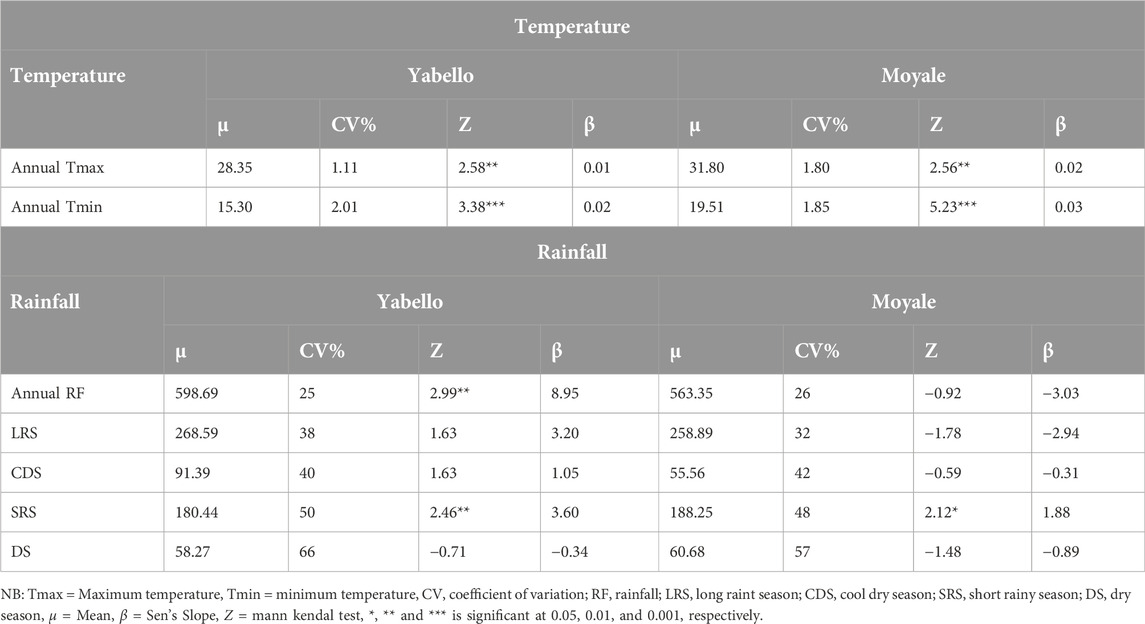
Table 6. Temperature and rainfall variability, Mann-Kendal trends and Sen’s Slop analysis (1990–2023).
As indicated in Figures 5A–D, the annual mean maximum and minimum temperature records of Yabello and Moyale districts were regressed to validate the respondents’ perceptions with the trends of meteorological data over the last 34 years. Consequently, the regression results show increasing trends in mean maximum and minimum temperatures, as indicated by the trend line equations y = 0.0156x + 26.077 and y = 0.0182x + 14.986; y = 0.0236x + 31.383 and y = 0.0293x + 18.999 for Yabello and Moyale districts, respectively. The slope of the positive coefficient reveals an increasing trend in the annual mean maximum and minimum by an approximate value of 0.02 for Yabello and 0.03 for Moyale district. These results are therefore less than the projected global warming rate of 0.6 in the 21st century. The mean maximum annual temperature in Yabello and Moyale stations was 28.33°C and 31.80°C, whereas the annual mean minimum temperature was 15.30°C and 19.51°C, respectively, over the last 34 years. In the previous three decades, it was found that the maximum and minimum temperatures were increasing significantly (P < 0.01) at Yabello and Moyale stations from 27.50°C (1990) to 28.41°C (2023), whereas the minimum temperature was raised from 14.90°C (1990) to 16.07°C (2023). Similarly, at Moyale station, the maximum temperature increased significantly from 30.87°C (1990) to 31.42°C (2023), while the minimum temperature rose from 18.97°C (1990) to 19.81°C (2023) (Figures 5A–D). According to data from the National Meteorological Agency of Ethiopia, there has been a noticeable increase in temperatures in the Borana area from 1990 to 2023. The average annual temperature has risen gradually, leading to longer and more intense dry seasons. These temperature trends have significant implications for camel production, as camels are sensitive to heat stress and require specific environmental conditions to succeed.
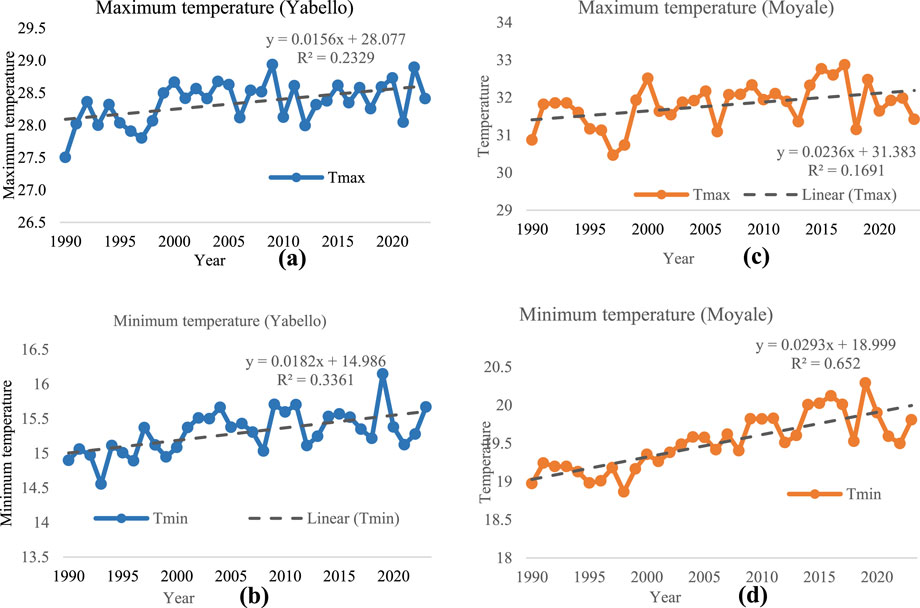
Figure 5. Annual mean maximum (a) and minimum (b) temperature trends of Yabello; Annual mean maximum (c) and minimum (d) temperature trends of Moyale (1990–2023).
Historical rainfall trends and variabilities
The mean annual and seasonal rainfall as well as the coefficient of variations in the last 34 (1990–2023) years in study areas are indicated in Table 6. The total annual average and coefficient of variation of rainfall were 598.69 mm and 25%, and 563.35 mm and 26%, respectively, in Yabello and Moyale districts during the last study period. In both districts, medium variability of annual rainfall was observed throughout the last 34 years of study time. The Mann-Kendall’s test result for Yabello total annual rainfall data indicated significant increasing trends (P < 0.01) over the last study period. Similarly, a recent study conducted in the region by Worku et al. (2022) reported that the trend of annual rainfall was significantly increasing from 1981 to 2018. They also stated that the northeast received relatively better rainfall than any other areas of Borana and decreased toward the southwest over the years. Another study conducted by Belay et al. (2021) in the southern part of Ethiopia reported an increasing trend of rainfall. In addition, recent studies conducted by Mohammed et al. (2022) and Gedefaw (2023) stated that the rainfall showed, respectively, positive and increasing trends in the upper blue Nile basin and in 70.03 percent of 47 rainfall stations in Ethiopia. However, in contrast to the metrology data of Yabello district, the majority of pastoralists and agro-pastoralists, key informants, and participants in focus group discussions clarified that the amount of rainfall was decreasing from time to time with high variabilities.
Unlike Yabello, the trend of total annual rainfall in Moyale districts was decreasing, but not significantly. In agreement with the current study of Moyale district meteorological data, Mihiretu et al. (2021) and Habte et al. (2022) reported decreasing patterns of annual rainfall in Abergelle district and southeast Ethiopia, respectively. Moreover, the distributions of annual rainfall in Yabello and Moyale districts are indicated in Figures 6, 7, respectively. In the study areas, respectively, the highest rainfall was recorded in 2023 (943.87 mm) and 1997 (890.56 mm) in Yabello and Moyale districts. On the other hand, in both stations, the lowest rainfall was recorded in 2000 in Yabello (401.07 mm) and Moyale (335.40 mm) districts. In the Borana area, major rainfall occurs in the long rainy season (March to April) and the short rainy season (September to November). It has been observed that high seasonal rainfall variabilities ranging from 32% to 66% were recorded during the last 34 years in the study areas. In line with this study, Belay et al. (2021) and Habte et al. (2022) reported higher seasonal rainfall variabilities in south and south-east Ethiopia, respectively. The highest variabilities reveal that there is no wise consistency in seasons of rainfall distribution. Moreover, the significance of seasonal rainfall was also analyzed using Mann-Kendal trend tests (Table 6). Mann-Kendal trend tests show that only the short rainy season is increasing significantly in both Yabello and Moyale districts. However, the long rainy and cool dry rainfall trend was not significantly increasing in Yabello district. Further, the dry season in Yabello district, long rainy, cool dry, and dry seasons were not decreasing significantly (Table 6). Seasonal rainfall distributions in Yabello and Moyale districts for long rainy, short rainy, cool dry, and dry seasons are shown in Figures 5A–D. The total annual distribution of long rainy season rainfall in Yabello and Moyale districts ranged from 99.10 mm to 573.87 mm and 83.55 mm–413.9 mm, respectively, during the last three decades. The annual distribution of short rainy seasons also varies from 42.47 mm to 420 mm in Yabello and 89.66 mm–489.63 mm in Moyale districts. Moreover, cool dry seasons range from 23.44 mm to 179.28 mm and 20.45 mm–103.66 mm in Yabello and Moyale districts, respectively.
The distribution of annual dry season rainfall also varies from 19.65 mm to 189.37 mm in Yabello and 20.69 mm–173.81 mm in Moyale districts. In addition, the linear trend analysis was used to compute the pattern of total seasonal rainfall during the study period. The analysis of precipitation data for the last 34 years (1990–2023) of the historical period reveals that there were medium annual variations of rainfall distributions in the study areas. In this study, the inter-annual variation of seasonal rainfall is found to be very high, which is strongly supported by the report of Habte et al. (2022) in a semi-arid area of Borana, southern Ethiopia. Declining and increasing trends as well as variability in rainfall were seen in the study areas, confirming that the major camel herders in the Borana areas who raised camels perceived that the seasonal rainfall had been varying and unpredicted, both in terms of quantity and distribution.
Conclusion
The result of the current survey indicated that the climate is variable and difficult to predict in the study area. The majority of camel herders perceived that there was an increase in temperature trends and variability in annual and seasonal rainfall. In addition, major respondents observed late onset of rainfall and decreased amount, duration, and intensity of rainfall. The majority of camel herders’ perceptions were in agreement with the meteorological results. The meteorological results showed that the annual mean maximum and minimum temperatures were increasing. On the other hand, rainfall data showed medium and high variation annually and seasonally, respectively. Declining and increasing trends as well as variability in rainfall were seen in the study areas, confirming that the major respondents in the Borana areas who raised camels perceived that the seasonal rainfall had been varying and challenging to predict, both in terms of quantity and distribution. The gradual increase in the average annual temperature and seasonal and annual rainfall variability leads to longer and more intense dry seasons and shortages of camel feed. Camel herders in the study area stated that camels are considered to have more adaptive mechanisms, producing milk for a longer time during drought, and have higher milk production and market prices compared to other milking animals in Borana areas. However, respondents reported that climate change and variability have affected camels’ health, productivity, and reproductive performance in the past three decades. Most camel herders use their indigenous knowledge of adaptation mechanisms in response to climatic threats. Government police and other stakeholders should consider indigenous knowledge of camel herders’ climate perception and adaptation methods while developing climate change prediction and adaptation strategies that are essential to reducing the impacts of climate change and variability and increasing the resilience of camel owners in the study areas.
Data availability statement
The data used in this study are available from the corresponding author upon request to interested.
Ethics statement
The studies involving humans were approved by the Haramaya University Research Ethics Committee. The studies were conducted in agreement with the local regulations and official requirements. The participants signed consent form to participate in this study.
Author contributions
BB: conceptualization, research, formal analysis, data gathering, data analysis, writing the original draft, reviewing, and editing; ME: planning, supervision, directing, reviewing, and revising; TW: conceptualization; supervision; review and editing; TB: planning, supervision, directing, reviewing, and revising; UG: conceptualization; supervision; review and editing; SG: conceptualization; supervision; review and editing. All authors reviewed the results and approved the final version of the manuscript.
Funding
The author(s) declare that no financial support was received for the research and/or publication of this article.
Acknowledgments
The authors are pleased to thank the Oromia Agricultural Research Institute for sponsoring this research work. We would also like to acknowledge Yabello Pastoral and Dryland Agriculture Research Center and Dairy Research Team for their logistical support during survey data collection. The National Metrology Institute is also thanked for providing climate data. The zonal and district experts, development agents, camel herders who participated in the interview are greatly appreciated and acknowledged.
Conflict of interest
The authors declare that the research was conducted in the absence of any commercial or financial relationships that could be construed as a potential conflict of interest.
Generative AI statement
The authors declare that no Generative AI was used in the creation of this manuscript.
References
Abara, M., Komariah, N., and Budiastuti, S. (2020). Drought frequency, severity, and duration monitoring based on climate change in southern and southeastern Ethiopia. IOP Conf. Ser. Earth Environ. Sci. 477 (1), 012011–012015. doi:10.1088/1755-1315/477/1/012011
Abebe, K. (2017). Effect of climate change on nutritional supply to livestock production. Res. J. Agric. Sci. 5, 98–106. doi:10.14662/ARJASR2016.056
Abri, M. A. A., and Faye, B. (2019). Genetic improvement in dromedary camels: Challenges and opportunities. Front. Genet. 10, 167. doi:10.3389/fgene.2019.00167
Al-Jassim, R., and Sejian, V. (2015). Review paper: Climate change and camel production: Impact and contribution. 8, 1–17. Available online at: https://www.cabdirect.org/cabdirect/abstract/20163045120.
Asiimwe, R., Ainembabazi, J. H., Egeru, A., Isoto, R., Aleper, D. K., Namaalwa, J., et al. (2020b). The role of camel production on household resilience to droughts in pastoral and agro pastoral households in Uganda. Pastoralism 10 (1), 5. doi:10.1186/s13570-020-0160-x
Assane, B., and Waoundé, D. (2023). Adaptation to climate change in arid lands: Evidence from pastoral areas of Senegal. Clim. Change Econ. 14 (1). doi:10.1142/s201000782350001x
Ayal, D. Y., Radeny, M., Desta, S., and Gebru, G. (2018). Climate variability, perceptions of pastoralists and their adaptation strategies. Int. J. Clim. Change Strategies Manag. 10 (4), 596–615. doi:10.1108/ijccsm-06-2017-0143
Belay, A., Demissie, T., Recha, J. W., Oludhe, C., Osano, P. M., Olaka, L. A., et al. (2021). Analysis of climate variability and trends in southern Ethiopia. Climate 9 (6), 96. doi:10.3390/cli9060096
Bogale, G. A., and Erena, Z. B. (2022). Drought vulnerability and impacts of climate change on livestock production and productivity in different agro-ecological zones of Ethiopia. J. Appl. Animal Res. 50 (1), 471–489. doi:10.1080/09712119.2022.2103563
Boudalia, S., Gueroui, Y., Zebsa, R., Arbia, T., Chiheb, A. E., Benada, M., et al. (2023). Camel livestock in the Algerian Sahara under the context of climate change: Milk properties and livestock production practices. J. Agric. Food Res. 11. doi:10.1016/j.jafr.2023.100528
Bowley, A. L. (1925). Measurement of the precision attained in sampling. Cambridge University Press.
Ciampittiello, M., Marchetto, A., and Boggero, A. (2024). Water resources management under climate change: a review. Sustainability 16 (9), 3590. doi:10.3390/su16093590
Coppock, D. L. (1994). The Borana plateau of southern Ethiopia: synthesis of pastoral research, development and change, 1980–91, 374. Addis Ababa. ILCA (International Livestock Centre for Africa) systems study no. 5.
CSA (2021). CSA (central statistical agency). Agricultural sample survey, federal democratic republic of Ethiopia report on livestock and livestock characteristics. 2020/21. Volume ІІ March 2021, Addis Ababa, Ethiopia.
Debela, N., Mohammed, C., Bridle, K., Corkrey, R., and McNeil, D. (2015). Perception of climate change and its impact by smallholders in pastoral/agropastoral systems of Borana, south Ethiopia. SpringerPlus 4 (1), 236. doi:10.1186/s40064-015-1012-9
Demem, M. S. (2023). Impact and adaptation of climate variability and change on small-holders and agriculture in Ethiopia: a review. Heliyon 9 (8), e18972. doi:10.1016/j.heliyon.2023.e18972
Dirriba, M., Simbone, T., and Bely, B. (2020b). Pastoral farming system and its temporal shift: a case of Borana zone, Oromia national regional state, Ethiopia. Afr. J. Agric. Res. 16 (9), 1233–1238. doi:10.5897/ajar2018.13847
Frumkin, H., Fried, L., and Moody, R. (2012). Aging, climate change, and legacy thinking. Am. J. Public Health. 102 (8), 1434–1438. doi:10.2105/ajph.2012.300663
Gaffney, J. (2019). Dairy production and milk consumption in pastoral areas of Ethiopia. AAHDS 1 (5). doi:10.33552/aahds.2019.01.000522
Gatew, S., and Guyo, N. (2024). Livelihood vulnerability of Borana pastoralists to climate change and variability in southern Ethiopia. Int. J. Clim. Change Strategies Manag. 16 (1), 157–176. doi:10.1108/IJCCSM-06-2023-0077
Gedefaw, M. (2023). Assessment of changes in climate extremes of temperature over Ethiopia. Cogent Eng. 10 (1). doi:10.1080/23311916.2023.2178117
Geilfus, F. (2008). 80 tools for participatory development: Appraisal, planning, follow-up and evaluation (9290399104).
Godde, C. M., Mason-D’Croz, D., Mayberry, D. E., Thornton, P. K., and Herrero, M. (2021). Impacts of climate change on the livestock food supply chain; a review of the evidence. Glob. Food Secur. 28, 100488. doi:10.1016/j.gfs.2020.100488
Habte, M., Eshetu, M., Maryo, M., Andualem, D., and Legesse, A. (2022). Effects of climate variability on livestock productivity and pastoralists perception: the case of drought resilience in southeastern Ethiopia. Veterinary Animal Sci. 16, 100240. doi:10.1016/j.vas.2022.100240
Hare, W. (2003). Assessment of knowledge on impacts of climate change - contribution to the specification of Art. 2 of the UNFCCC: impacts on Ecosystems. Food Prod. Water Socio-economic Syst. Available online at: https://digital.library.unt.edu/ark:/67531/metadc12057/.
Hasanpour Kashani, M., and Dinpashoh, Y. (2012). Evaluation of efficiency of different estimation methods for missing climatological data. Stoch. Environ. Res. Risk Assess. 26, 59–71. doi:10.1007/s00477-011-0536-y
Huo, J., and Peng, C. (2023). Depletion of natural resources and environmental quality: Prospects of energy use, energy imports, and economic growth hindrances. Resour. Policy 86, 104049. doi:10.1016/j.resourpol.2023.104049
Iwueze, I. S., Nwogu, E. C., Nlebedim, V. U., Nwosu, U. I., and Chinyem, U. E. (2018). Comparison of methods of estimating missing values in time series. Open J. Statistics 08, 390–399. doi:10.4236/ojs.2018.82025
Jrad, Z., Oussaeif, O., and El-Hatmi, H. (2024). “Recent trends on camel milk cheese processing: Nutritional and health value,” in IntechOpen eBooks. doi:10.5772/intechopen.114032
Kandil, H., Wassif, I. M., Rabee, A., Shokry, M. M., Khidr, R. E. S., and Askar, A. (2023). Camel, the animal of food security and climate change. Egypt. J. Camel Sci. 1 (1), 1–8. doi:10.21608/ejcs.2023.220447.1008
Kargbo, A., Jawo, E., Amoutchi, A. I., Ndow, M., Bojang, A., Zainabou, D., et al. (2023). Perceptions and impacts of climate variability on livestock farming in the Gambia. J. Appl. Animal Res. 51 (1), 366–374. doi:10.1080/09712119.2023.2203765
Kasu, H. B. (2022). Impact of deforestation in Ethiopia. J. Selva Andina Biosph. 10 (2), 86–95. doi:10.36610/j.jsab.2022.100200086x
Kebede, S., Animut, G., and Zewudu, L. (2015). “The contribution of camel milk to pastoralist livelihoods in Ethiopia: an economic assessment in somali regional state,” in IIED country report. London: IIED.
Kemal, A. W., Mohammed, A. A., and Lelamo, L. L. (2022). Pastoralists’ adaptation strategies to climate change and determinant factors in Korahey zone, Ethiopia. AJCC 11 (02), 79–102. doi:10.4236/ajcc.2022.112005
Kena, D. (2022). Review on camel production and marketing status in Ethiopia. Pastoralism 12, 38. doi:10.1186/s13570-022-00248-2
Kimaro, E. G., Mor, S. M., and Toribio, J. A. L. M. L. (2018). Climate change perception and impacts on cattle production in pastoral communities of northern Tanzania. Pastoralism 8 (1), 19. doi:10.1186/s13570-018-0125-5
Koluman Darcan, N. (2023). Goats and their role in climate change. Small Ruminant Res. 228, 107094. doi:10.1016/j.smallrumres.2023.107094
Leon, M., Cornejo, G., Calderón, M., González-Carrión, E., and Florez, H. (2022). Effect of deforestation on climate change: A co-integration and causality approach with time series. Sustainability 14 (18), 11303. doi:10.3390/su141811303
Megersa, B., Markemann, A., Angassa, A., Ogutu, J. O., Piepho, H. P., and Valle Zaráte, A. (2014). Impacts of climate change and variability on cattle production in southern Ethiopia: Perceptions and empirical evidence. Agric. Syst. 130, 23–34. doi:10.1016/j.agsy.2014.06.002
Megersa, B., Markemann, A., Angassa, A., and Valle Zárate, A. (2013). The role of livestock diversification in ensuring household food security under a changing climate in Borana, Ethiopia. Food Secur. 6 (1), 15–28. doi:10.1007/s12571-013-0314-4
Megersa, B., Temesgen, W., Amenu, K., Asfaw, W., Gizaw, S., Yussuf, B., et al. (2024). “Camels in Ethiopia: an overview of demography, productivity, socio-economic value and diseases,” in ILRI research report 121 (Nairobi, Kenya: International Livestock Research Institute ILRI).
Mekuyie, M., and Mulu, D. (2021). Perception of impacts of climate variability on pastoralists and their adaptation/coping strategies in Fentale district of Oromia region, Ethiopia. Environ. Syst. Res. 10 (1), 4. doi:10.1186/s40068-020-00212-2
Mengistu, D., and Haji, J. (2016). Traditional coping strategies of Borana pastoralists for climate extremes: A case of Yabello district, Borana zone, Ethiopia. IJEIR 5 (3), 210–216. Available online at: http://ijeir.org/index.php/issue?view=publication&task=show&id=599.
Mihiretu, A., Okoyo, E. N., and Lemma, T. (2021). Causes, indicators and impacts of climate change: Understanding the public discourse in goat based agro-pastoral livelihood zone, Ethiopia. Heliyon 7 (3), e06529. doi:10.1016/j.heliyon.2021.e06529
Mirkena, T., Walelign, E., Tewolde, N., Gari, G., Abebe, G., and Newman, S. (2018). Camel production systems in Ethiopia: A review of literature with notes on MERS-CoV risk factors. Pastoralism 8, 30. doi:10.1186/s13570-018-0135-3
Mohammed, J. A., Gashaw, T., Tefera, G. W., Dile, Y. T., Worqlul, A. W., and Addisu, S. (2022). Changes in observed rainfall and temperature extremes in the upper blue Nile basin of Ethiopia. Weather Clim. Extrem. 37, 100468. doi:10.1016/j.wace.2022.100468
Musa, L. M. A., Peters, K. J., and Ahmed, M. K. A. (2006). On-farm characterization of Butana and Kenana cattle breed production systems in Sudan. LRRD. 18, 177.
National Meteorology Agency (NMA) (2007). National adaptation programme of action. Addis Ababa, Ethiopia.
Ochieng, J., Kirimi, L., and Makau, J. (2016). Adapting to climate variability and change in rural Kenya: Farmer perceptions, strategies and climate trends. Nat. Resour. Forum 41, 195–208. doi:10.1111/1477-8947.12111
Olaniyan, O. F., and Orunmuyi, M. (2017). “Promoting farmer’s resilience to climate change: an option of the N’Dama cattle in West Africa,” in Climate change adaptation in african. Editors W. Leal, J. Kalangu, B. Simane, and M. Wuta (Climate Change Management. Springer), 345–356. doi:10.1007/978-3-319-49520-0_2
Rodrigues, C. I. D., Brito, L. M., and Nunes, L. J. R. (2023). Soil carbon sequestration in the context of climate change mitigation: a review. Soil Syst. 7 (3), 64. doi:10.3390/soilsystems7030064
Saharan, H., Sharma, A., and Beniwal, A. (2023). Camel milk consumption trends and drivers in Rajasthan, India: a consumer behaviour study. AJAEES 41 (6), 57–69. doi:10.9734/ajaees/2023/v41i61921
Salah, A., Liu, X. H., Tareke, K. M., Azad, M., and Fikru, F. A. (2024). The impact of climate change and climate variability on the pastoralist communities in Moyle district, Somali regional state, Ethiopia. OALib 11 (5), 1–11. doi:10.4236/oalib.1111582
Sanogo, K., Binam, J., Bayala, J., Villamor, G. B., Kalinganire, A., and Dodiomon, S. (2016). Farmers’ perceptions of climate change impacts on ecosystem services delivery of parklands in southern Mali. Agrofor. Syst. 91 (2), 345–361. doi:10.1007/s10457-016-9933-z
Saroar, M. M., and Filho, W. L. (2016). Adaptation through climate smart agriculture: Status and determinants in coastal Bangladesh. Clim. change Manag. 157 (178), 157–178. doi:10.1007/978-3-319-39880-8_10
Sen, P. K. (1968). Estimates of the regression coefficient based on Kendall’s tau. J. Am. Stat. Assoc. 63, 1379–1389. doi:10.1080/01621459.1968.10480934
Shibru, M., Opere, A., Omondi, P., and Gichaba, M. (2023). Understanding physical climate risks and their implication for community adaptation in the Borana zone of southern Ethiopia using mixed-methods research. Sci. Rep. 13, 6916. doi:10.1038/s41598-023-34005-1
Steer, A. (2014). “Resource depletion, climate change, and economic growth,” in Towards a better global economy: policy implications for citizens worldwide in the 21st century, 381–246.
Tamene, H., Ayal, D. Y., Zeleke, T. T., and Ture, K. (2023). Determinants of the choice of adaptation strategies to climate variability and extremes among pastoralist and agro-pastoralist households in Yabello and Arero districts, southeast Ethiopia. Clim. Serv. 30, 100381. doi:10.1016/j.cliser.2023.100381
Tofu, D. A., Fana, C., Dilbato, T., Dirbaba, N. B., and Tesso, G. (2023). Pastoralists’ and agro-pastoralists’ livelihood resilience to climate change-induced risks in the Borana zone, south Ethiopia: using resilience index measurement approach. Pastoralism 13 (1), 4. doi:10.1186/s13570-022-00263-3
Tolera, A., and Abebe, A. (2007). Livestock production in pastoral and agro-pastoral production systems of southern Ethiopia. LRRD 19 (12), 4–7. Available online at: http://www.lrrd.org/lrrd19/12/tole19177.htm.
Wako, G., Tadesse, M., and Angassa, A. (2017). Camel management as an adaptive strategy to climate change by pastoralists in southern Ethiopia. Ecol. Process. 6 (1), 26. doi:10.1186/s13717-017-0093-5
Wako, W., Chala, D. G., Gemede, N. J., and Ero, D. (2023). Indigenous social protection mechanism: The practices and challenges of buusaagonofaa in the Borana Oromo, southern Ethiopia. JRCD 18, 84–102. Available online at: https://journals.brandonu.ca/jrcd/article/view/2292/627.
Worku, M. A., Feyisa, G. L., and Beketie, K. T. (2022). Climate trend analysis for a semi-arid Borana zone in southern Ethiopia during 1981–2018. Environ. Syst. Res. 11 (1), 2. doi:10.1186/s40068-022-00247-7
World Bank (2010). The social dimensions of adaptation to climate change in Ethiopia. Dev. Clim. change Discuss. Pap. No. 14. Washington DC. Available online at: http://documents.worldbank.org/curated/en/832981468326977324.
Wubaye, G. B., Gashaw, T., Worqlul, A. W., Dile, Y. T., Taye, M. T., Haileslassie, A., et al. (2023). Trends in rainfall and temperature extremes in Ethiopia: Station and agro ecological zone levels of analysis. Atmosphere 14 (3), 483. doi:10.3390/atmos14030483
Yahaya, I., Xu, R., Zhou, J., Jiang, S., Su, B., Huang, J., et al. (2024). Projected patterns of land uses in Africa under a warming climate. Sci. Rep. 14 (1), 12315. doi:10.1038/s41598-024-61035-0
Keywords: Borana zone, camel herders, camel production, climate variability, pastoralist, perception
Citation: Bekele B, Eshetu M, Wolkero T, Berhe T, Galmessa U and Gadissa S (2025) Perception of camel herders on climate change and variability in relation to camel production in Borana zone, Southern Ethiopia. Pastoralism 15:13986. doi: 10.3389/past.2025.13986
Received: 25 October 2024; Accepted: 25 March 2025;
Published: 14 April 2025.
Edited by:
Derradji Harek, Algerian National Institute for Agronomic Research INRAA, AlgeriaCopyright © 2025 Bekele, Eshetu, Wolkero, Berhe, Galmessa and Gadissa. This is an open-access article distributed under the terms of the Creative Commons Attribution License (CC BY). The use, distribution or reproduction in other forums is permitted, provided the original author(s) and the copyright owner(s) are credited and that the original publication in this journal is cited, in accordance with accepted academic practice. No use, distribution or reproduction is permitted which does not comply with these terms.
*Correspondence: Birhanu Bekele, YmlyaGFudWJla2VsZWhvMjFAZ21haWwuY29t
 Birhanu Bekele
Birhanu Bekele Mitiku Eshetu2
Mitiku Eshetu2 Sileshi Gadissa
Sileshi Gadissa